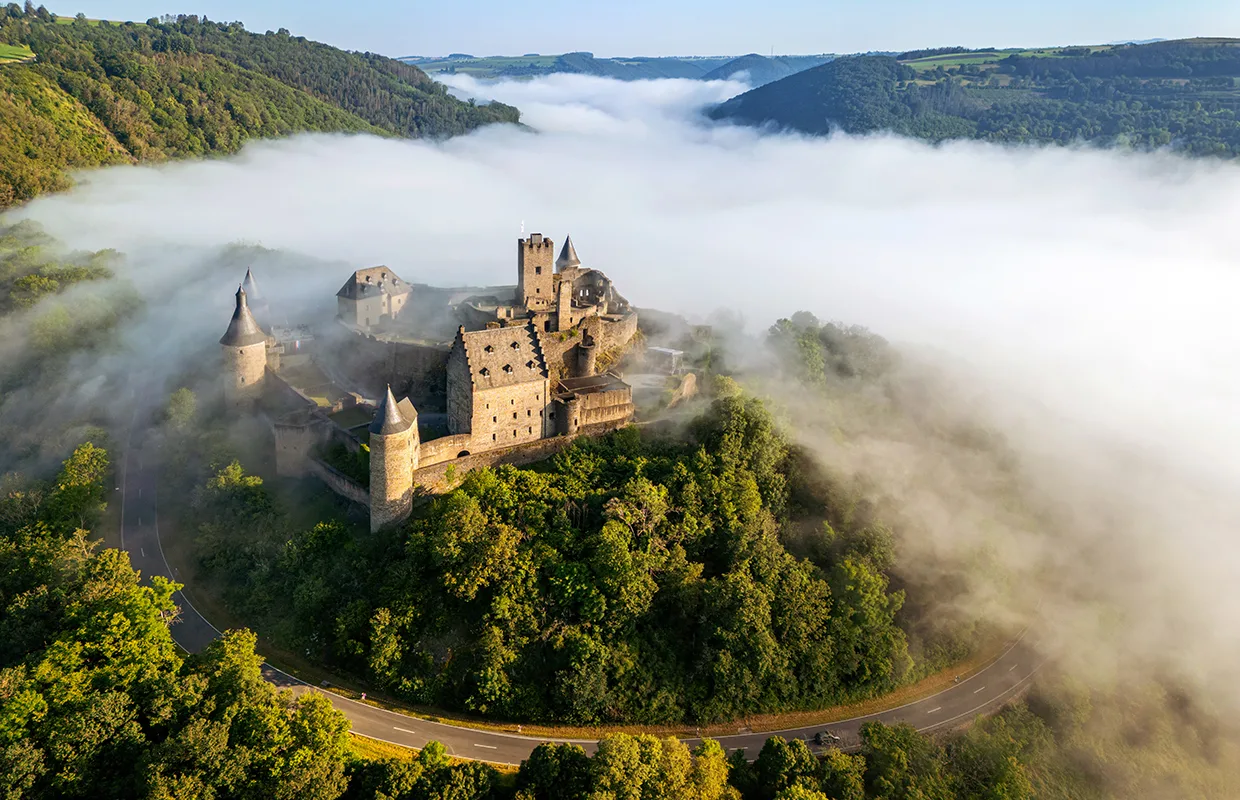Medieval charm meets contemporary chic in Luxembourg, a small multicultural country in the heart of Europe with a unique blend of historic fortresses, lush landscapes, and cosmopolitan elegance all found in close proximity and ready to be explored.
LUXEMBOURG
Luxembourg is a colourful country with recognisable influences from Europe and all over the world. Yet, the nation has its own distinctive culture and character.
Many visitors begin their stay in the vibrant capital, Luxembourg City, where world-famous artists rub shoulders with newcomers and old fortress walls meet modern architecture.
History buffs will not want to miss the bastions and casemates of the capital’s fortifications, a reminder of the period between the 16th and 19th centuries when Luxembourg was a fortress and regarded as the ‘Gibraltar of the North’.
Elsewhere, away from the capital, there are five other unique regions in the country that await discovery. Luxembourg City is almost entirely surrounded by Guttland, the garden of the capital city, which welcomes visitors with lush countryside and the characteristic Valley of the Seven Castles.
To the north, Éislek captivates with its rugged natural beauty, panoramic views, and famous castles, whilst Mullerthal – also known as ‘Luxembourg’s Little Switzerland’ – is home to magical and mythical rock formations and dense forests, a paradise for fans of outdoor leisure.
In Moselle, visitors to the east of the country have the opportunity to enjoy fine local wines and specialities in picturesque towns and villages amid the vineyards, with the wine village of Schengen standing as a synonym for modern Europe.
Minett, or the ‘Land of the Red Rocks’, fascinates visitors and catches the eye with glowing red iron ore that dominates the natural landscape.
Travel to these regions is free-of-charge on Luxembourg’s nationwide public transport, becoming the first country in the world to abolish fares for trains, trams, and buses.
With one of the densest networks of hiking trails in Europe, Luxembourg is the ideal travel destination for hikers. Routes such as the 112-kilometre (km) Mullerthal Trail are packed with challenges and lead through a wonderful variety of sometimes wild and unspoilt landscapes.
Éislek, meanwhile, is the continent’s first certified quality hiking region, having been awarded the ‘Leading Quality Region – Best of Europe’ certification by the European Ramblers Association, offering over 200 circular hiking trails through forests, past castles, over high plateaus, and between rocks.
Foodies likewise love exploring Luxembourg’s high-quality cuisine. From iconic Moselle still and sparkling wines to Mullerthal cheeses and cider, the country’s chefs and craftspeople are experts in the culinary arts and serve passion with every product and dish.
Despite being a small country spanning an area of just 2,600 square kilometres (sqkm), the Grand Duchy boasts a delightful capital, five distinct regions with diverse landscapes, a rich cultural scene, plenty of history, and a paradise for food enthusiasts.
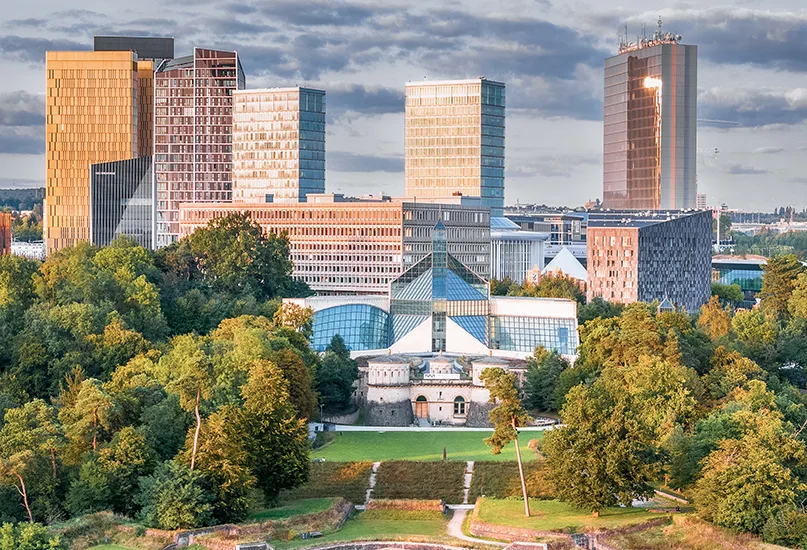
Q&A WITH VISIT LUXEMBOURG
We discover the enchanting allure of Luxembourg, from the cultural hub of the capital to its five unique regions, hiking trails, and culinary diversity with Dr Sebastian Reddeker, CEO of Visit Luxembourg.
Firstly, can you introduce us to Visit Luxembourg as the country’s national destination marketing organisation?
Dr Sebastian Reddeker, CEO (SR): Visit Luxembourg is a public-private partnership organisation representing a part of the country’s economy, specifically tourism.
We were actually founded many years ago as a national tourist office, then there was a structural switch and Luxembourg for Tourism (LFT) was born.
Historically we’re older than that, which is important because it’s a structure that people in Luxembourg know well, they appreciate that we’re there, and we have the local support to work not just inside the country but also on our main business, which is promoting Luxembourg elsewhere, mainly in our neighbouring countries.
How do you set about your mission to promote Luxembourg as a tourist destination globally?
SR: We do international marketing, and everything starts with research. We have an important research department where we have a look at all the trends and data.
We have a communications department, together with a marketing section that set up the international ‘Luxembourg. Live the moment.’ campaign we’re doing at the moment. The campaign is basically 90 percent online and we are active on social media platforms, such as Instagram and Facebook which are increasingly important.
As demand remains, we are still present at fairs with our Visit Luxembourg stand, even though it was predicted after the COVID-19 pandemic that such events would cease to be popular. However, they’re still very important for us, especially thematic fairs for hiking and biking. We still do some classic PR work and have a wide range of print materials to accompany our digital platforms and products.
Our destination magazine Luci has received 12 international design awards. I think it’s very important to set up a destination magazine that has a certain quality made to keep and is not just another brochure to take and throw away.
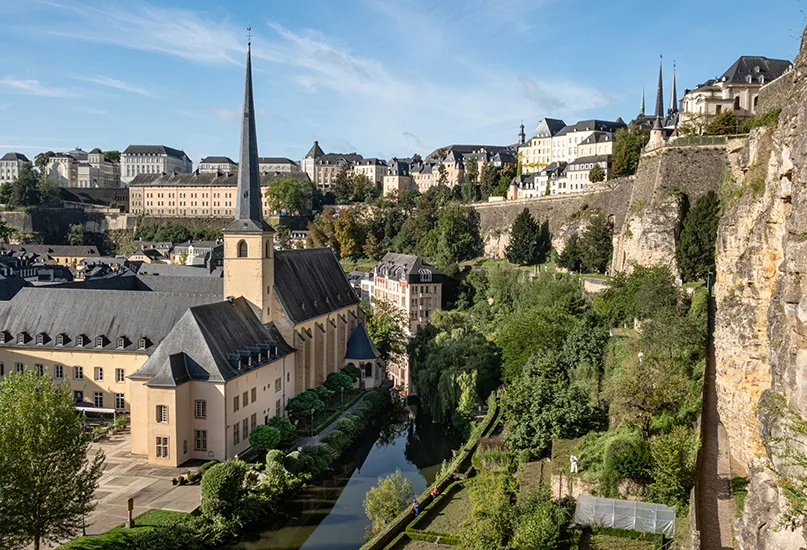
Why, in your opinion, should someone visit Luxembourg and discover its enchanting allure?
SR: Luxembourg for a lot of people is still a very unknown destination, but it’s worth visiting. It’s not just a city; there’s a whole country and five regions around it.
It’s a small 2,600 sqkm territory, but we have the hilly region of Éislek in the north that is part of the Ardennes. We also have the former industrial region of Minett in the south with a very interesting heritage, Mullerthal with its sandstone formations in the east, Guttland’s idyllic countryside in the centre, and the Moselle with its vineyards.
There is a variety of landscapes and experiences to discover. The combination of city and outdoors, accompanied by good food, is often a winner and easy to plan because of the short distances.
What tourist attractions and experiences would you recommend in the capital, Luxembourg City?
SR: The capital is the cultural hub of the country. European institutions are based here, and we have our cultural spots like the Philharmonie Luxembourg, Grand Théâtre, and many others.
Nearly all the nations you can find on Earth mingle and form this multicultural, multilingual society. Luxembourg is a historic place because of the fortress that was constructed over the centuries. It defines the cityscape, co-existing alongside the modern capital it has become. As a visitor, you can experience this microcosm of Europe.
As well as diving into the capital, why should tourists also tour the country’s five unique regions?
SR: In under an hour from the capital, you can be in any of the country’s five regions. Where to go depends on what you like to do, but you’ll be surprised at just how much a small country has to offer.
Starting in the north, the hills and castles of Éislek invite visitors to hike and bike on trails in stunning natural surroundings.
Mullerthal is famous for its sandstone formations and the Mëllerdall UNESCO Global Geopark, which is a magnet for hikers and campers. Here, you also have Luxembourg’s oldest town of Echternach with its wonderful abbey.
Guttland in the centre is the place to go for slow tourism experiences and the Valley of the Seven Castles.
Luxembourg’s vineyards and wine cellars are dotted along the Moselle river. Schengen is a picturesque village well-known to everybody who travels as the Schengen Agreement was signed there. Schengen and the Moselle are ideal to feel the European spirit, as well as for food and wine.
In the south, you have Minett, also known as the ‘Land of the Red Rocks’ because of the red earth. You can visit the remains of industrial production in Luxembourg, where they mined iron to produce steel, as well as explore a UNESCO Biosphere Reserve.

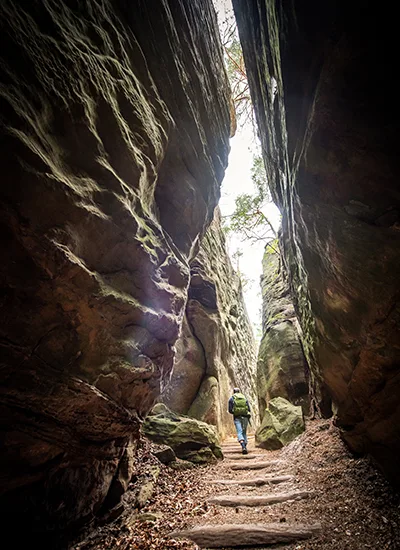
With one of the densest trail networks in Europe, what makes Luxembourg the ideal destination for hikers?
SR: Luxembourg has two routes certified by the European Ramblers Association as ‘Leading Quality Trails – Best of Europe’ in Éislek and Mullerthal.
We have different hiking levels, from comfort hikes which are accessible to all, up to high-end, multi-stage hiking trails which people come from far away to experience.
The 112km Mullerthal Trail can be split into three different circuits and gives you a fascinating experience of not only the Luxembourg countryside, but also the geological history of the country.
Equally, what inspiring cultural hotspots are there to discover in Luxembourg?
SR: In general, the cultural life is quite vibrant. In Luxembourg City alone, there are over 700 different events during the year and many of them are cultural.
Summer in the City offers months of free open-air concerts and festivals. Thousands of people come to City Sounds or Kinnekswiss Park to hear top artists including the Luxembourg Philharmonic Orchestra and international guests of all genres.
There’s also the Mudam, which houses contemporary art and is an architectural icon. Art is a very important aspect of cultural life in the country, and we have events such as Luxembourg Art Week and Lux Film Fest. Lots of them are held in public places, parks, and castles, so it’s definitely worth having a look at the agenda.

“In general, the cultural life is quite vibrant. In Luxembourg City alone, there are over 700 different events during the year and many of them are cultural”
Dr Sebastian Reddeker, CEO, Visit Luxembourg
Why do foodies also find themselves falling helplessly in love with the country?
SR: I would say it’s the diversity of culinary approaches that seduce the foodies. Traditional Luxembourg cuisine is rooted in the history of the country. That said, we have high-end French-style cuisine, a touch of German, and a lot of Portuguese and Italian influences, amongst others.
The quality of food and gastronomy in Luxembourg is really high. We have some Michelin-starred restaurants, but on the other hand, we also have a lot of street food and urban gardening projects.
To understand the culinary diversity of Luxembourg, it’s important to know that it’s not just a city. You can get to know the whole country’s agricultural production when you’re here.
Our cider farm in the east of country is also internationally recognised, with over 150 apple varieties to produce cider but also apple juice, so there are also some niche products that people definitely don’t know about yet.
“We are proud of our country, would like to show it to others, and are ready to welcome people”
Dr Sebastian Reddeker, CEO, Visit Luxembourg
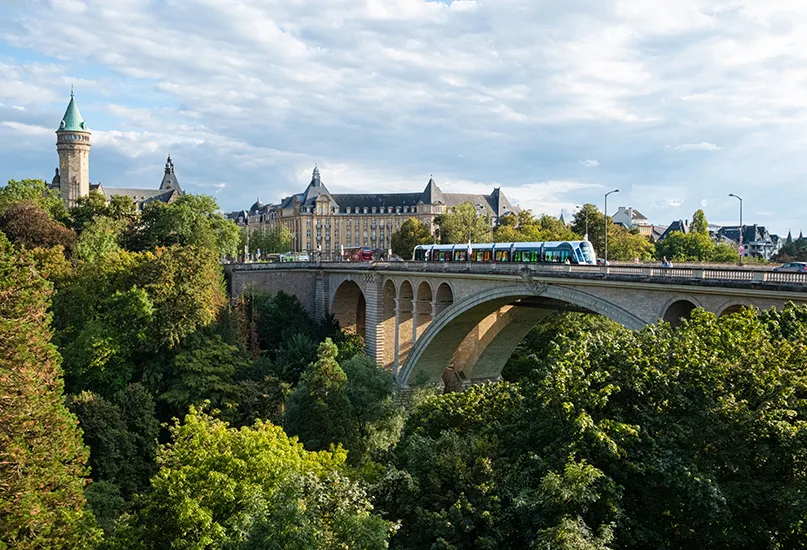
Finally, are you optimistic about the future of tourism in Luxembourg?
SR: I’m optimistic because if you compare the general evolution of tourism and the situation of Luxembourg, we have some clear advantages.
Firstly, the weather is not too hot for prolonged periods. The weather can be beautiful throughout the year, but it is not guaranteed, so we can’t promote Luxembourg as a sunny destination. We see more Spanish and Italian tourists coming during the summer because it’s too hot in Southern Europe. We also see many people looking to avoid crowded places choosing somewhere off the radar instead.
Luxembourg has an economic structure that is not completely reliant on tourism like many other destinations in Europe. I wouldn’t say tourism is an add-on, but there is space for you as a visitor, and your experience is not overcrowded or stressful in that sense at all.
There is considerable support for tourism from the local population, which is always important. We are proud of our country, would like to show it to others, and are ready to welcome people.
OUTLOOK RECOMMENDS
Eat:
FOR AN ODE TO LOVE AND EXCELLENCE…
Mosconi celebrates the passion for Italian flavours, the delicate marriage of creativity and rigour, and the triumph of culinary excellence.
It is a love story that unites Ilario and Simonetta Mosconi, who have been jazzing up the fine dining scene in Luxembourg since 1986. Originally from Lombardy, the couple welcomes you into a handsome townhouse steeped in swish elegance and boasting a terrace by the Alzette river.
Do:
FOR A WATER WORLD OF FUN AND WELLNESS…
AquaNat’Our offers families, amateur athletes, and professional swimmers an area of over 3,500 square metres for exercise and relaxation.

Whether you want to have fun in the swimming pool, enjoy a workout, or recharge your batteries in the sauna, there’s something for everyone.
You will find a diverse range of water activities at AquaNat’Our, including warm, cold, and natural pools, a steam bath, and an inviting lounge area.
The cold pool is a refreshing 16°C, ideal for revitalising the body and mind, promoting circulation, strengthening the immune system, and recovering after a workout. As soon as the temperatures rise, you can also cool off in the natural outdoor pool, which features a sophisticated self-cleaning system.
At 36°C, the warm pool invites you to relax and unwind with soothing bubble loungers, massage jets, and neck showers that relieve tension and stress.
Equally, the steam bath at AquaNat’Our offers the perfect opportunity for wellness and rejuvenation. The essential oils used have a positive effect on your respiratory system and lungs, whilst the high humidity deeply cleanses your skin.
The 12.5 metre (m) by 25m swimming pool offers ideal conditions for active swimmers, with an adjustable, moveable floor allowing for variable water depths ranging from 0.45m to 1.8m. This enables swimming conditions to be flexibly adapted to the needs of different groups, whether for training sessions, swimming lessons, or recreational swimming.
AquaNat’Our offers a wide range of aqua classes, from gentle movements to intense workouts, and swimming lessons for all levels, ensuring everyone learns at their own pace in a pleasant, supportive environment.
In addition, the swimming pool regularly hosts water games and activities for children, providing plenty of fun and variety.

FOR THE LARGEST BREWERY IN LUXEMBOURG…
Founded more than 260 years ago in 1764, Brasserie Nationale is an integral part of Luxembourg’s brewing landscape.

The family-owned business continues to put tradition, quality products, and constant innovation at the heart of its brands.
Bofferding is a 100 percent natural beer with no additives or preservatives. Brewed from the finest raw materials, it offers optimum taste, quality, and unrivalled freshness.
Luxembourg’s favourite beer is Battin, offering a complete range with each of its beers tailored to a specific drinking moment, whilst Funck-Bricher is brewed from certified organic malts and hops.
Brasserie Nationale follows a slow brewing method; its beers mature for five to six weeks, depending on the recipe, and are not pasteurised. The brewery also uses quality control to monitor and analyse every stage in the production of its beers.
A guided tour takes you behind the scenes of Brasserie Nationale and immerses you in more than two-and-a-half centuries of brewing history.
Other activities include a beer tasting session, in which you can discover and taste the brewery’s beers. Whether you’re a beer beginner, enthusiast, or professional, let Brasserie Nationale guide you on a journey of discovery for your taste buds through a variety of flavours derived from 100 natural products and traditional know-how.
Ever dreamed of brewing your own beer? You can also become a brewmaster for the day, with 150 litres of your beer in personalised bottles ready to be collected between six and eight weeks after. Alternatively, on Brasserie Nationale’s pouring course, learn how to serve the perfect beer at your fingertips.
FOR AUDIOVISUAL HERITAGE…
The main mission of the Centre National de l’Audiovisuel (CNA) is to safeguard, develop, and promote Luxembourg’s audiovisual and photographic heritage.
Since 2007, it has opened two exhibition spaces, a cinema (CinéStarlight), and a media library where you can consult and borrow various documents (Médiathèque). The centre has also developed various workshops for every age related to photography, sound, and moving images.
Its main attractions include The Family of Man, a legendary exhibition conceived as a manifesto for peace and the fundamental equality of mankind, expressed through the humanist photography of the post-war years. The Family of Man is part of the Steichen Collections, which assemble works connected to renowned Luxembourgish American photographer, Edward Steichen.
For unique cultural diversity in the world of sounds and images, visit CNA.
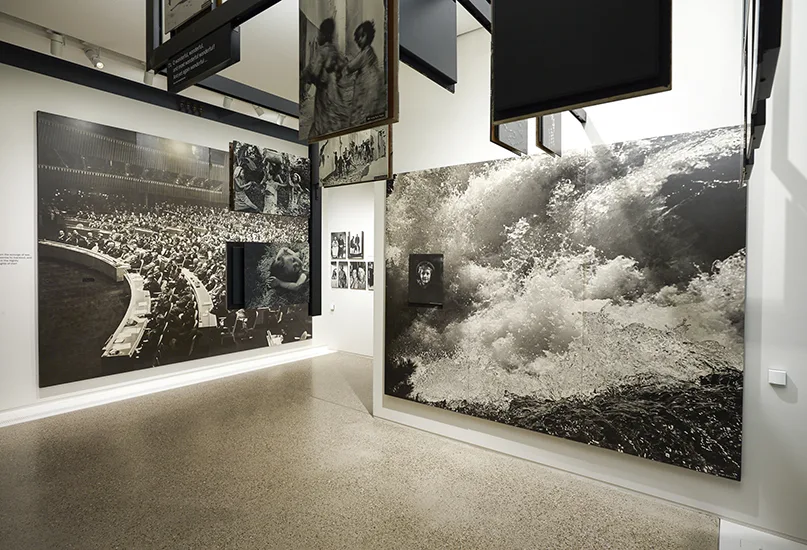
Sleep:
FOR A STAY WITH RELAIS & CHÂTEAUX…
Discover Villa Pétrusse, the rebirth of a historic architectural gem in the heart of Luxembourg City.

Nestled within an enchanting park along the banks of the Pétrusse river with views of the Adolphe Bridge, Villa Pétrusse is one of the last remaining bourgeois residences from the late 19th century.
The former Villa Baldauff had been abandoned for years but has been exquisitely preserved and recently opened to the public as a newly restored 5-star hotel in June.
Travel back in time in the refined elegance and old-world charm of a property that exudes the subtle, unostentatious warmth of a well-appointed family home inhabited by discerning art lovers.
There is an array of gastronomic experiences at Villa Pétrusse, which aspires to become a must-visit destination for culinary discovery in the country.
Nearby, the Hôtel Le Place d’Armes also offers a charming stay, ideally situated in the historic heart of Luxembourg.

Past and present are perfectly balanced in this 18th-century building as the hotel’s 30 luxury rooms and suites skilfully blend classic Art Nouveau and contemporary design, respecting the historic character of the site whilst favouring an intimate and warm décor.
The hotel’s gourmet restaurant, La Cristallerie, offers haute couture cuisine that reflects the seasons and is inspired by truly exceptional ingredients.
Both Villa Pétrusse and the Hôtel Le Place d’Armes are Relais & Châteaux properties. Established in 1954, Relais & Châteaux unites an exceptional collection of 580 unique independent luxury hotels and fine dining restaurants throughout the world.
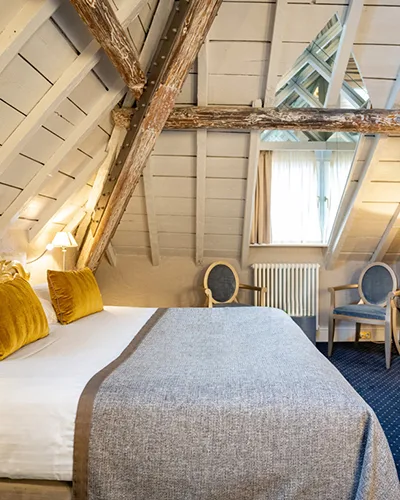
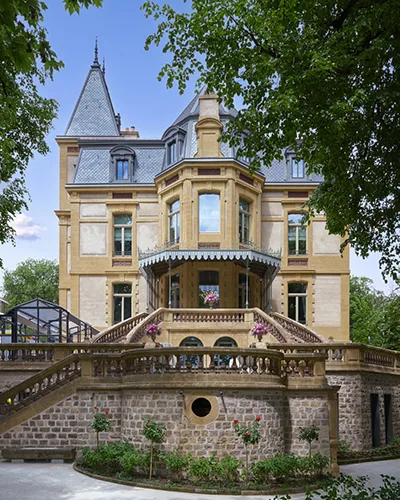
LUXEMBOURG CITY IN FOCUS
Built on the foundations of a formidable fortress, history and culture can be found at every turn in Luxembourg City.
From the capital’s Old Town – a UNESCO World Heritage Site – to the Pétrusse and Bock Casemates, there are must-see sights all within walking distance.
What strikes many visitors is the gorge splitting the city centre in two. The deep green river valleys and towering cliffs that characterise Luxembourg City’s unique topography were the area’s strength when Lucilinburhuc, meaning ‘small castle’, was established in 963 AD.
Over the course of its history, Luxembourg City has grown from Lucilinburhuc into the popular capital it is today and forged a new visual identity out of the castle ruins, building architectural gems such as the Adolphe Bridge, Place d’Armes, and Grand Ducal Palace, which is the official residence of the Grand Duke.
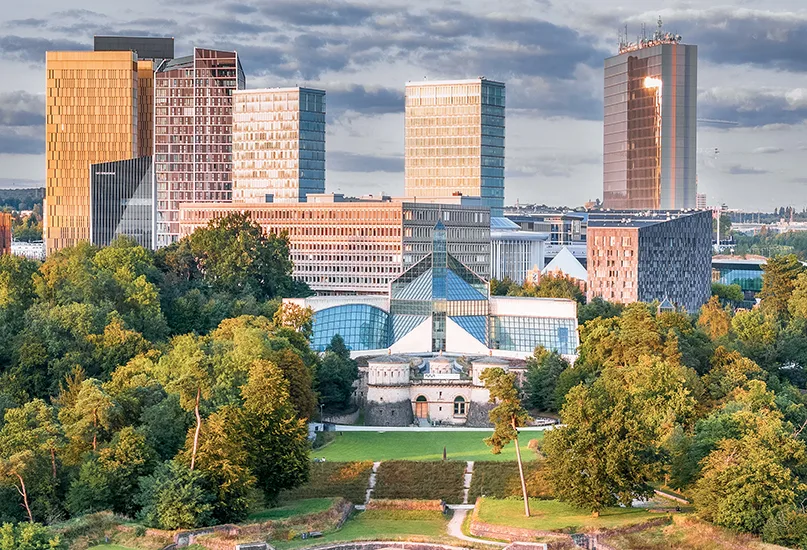
The palace is in the Ville Haute neighbourhood of the Old Town and unquestionably has one of the most beautiful façades in the capital.
Today, Luxembourg City continues to evolve architecturally, making it a top tourism destination. With cosy cafés and dining and accommodation for all budgets, it is the perfect location for a city break or weekend getaway.
An impressive array of annual events, such as the Schueberfouer funfair, Summer in the City, and Winterlights mean there is always something to do in Luxembourg City, no matter what time of year you visit.
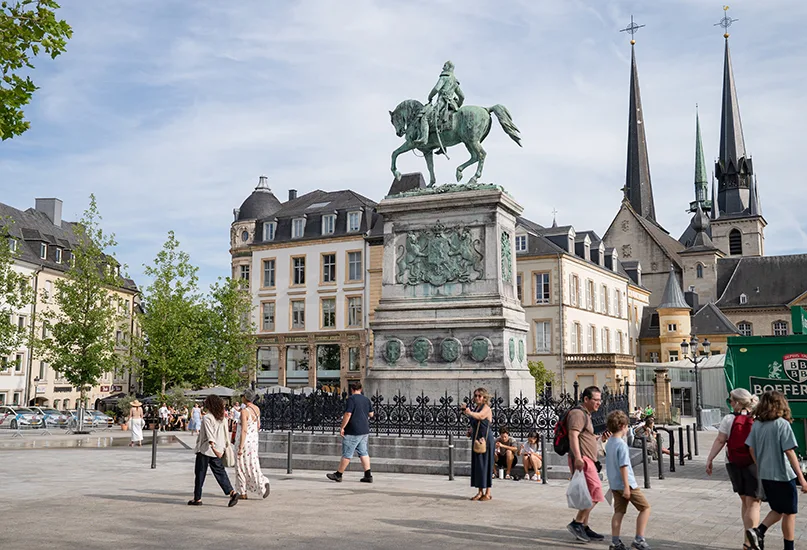
LANDMARK ATTRACTIONS
Grand Ducal Palace
For over a century, the Grand Ducal Palace has been the official residence of the Grand Duke and the place where he carries out his duties. Located at the heart of the capital, it embodies the closeness between the grand ducal family of Luxembourg and the country’s population.
Place d’Armes
Also named ‘Parlour of the City’, Place d’Armes is a square in Luxembourg City that originally served as a parade ground for troops defending the capital. Today, it is part of the pedestrian zone and surrounded by numerous cafés and restaurants, becoming the city’s main centre of activity and attracting both locals and visitors of all ages.
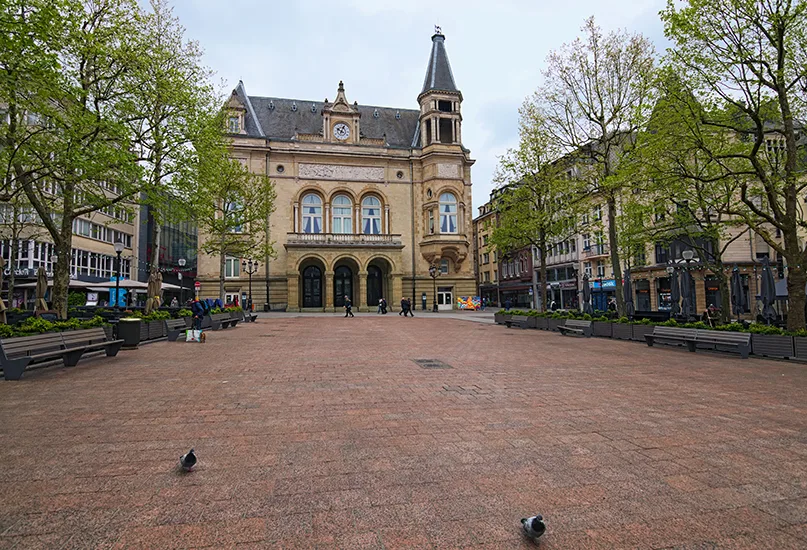
Bock Casemates
The Bock Casemates, a subterranean defence system made up of a series of tunnels, is one of the most important visitor sites in Luxembourg. Visiting the archaeological crypt, the antechamber to the casemates, is a similarly remarkable experience. On account of these impressive fortifications, Luxembourg was given the epithet of ‘Gibraltar of the North’.

GETTING THERE AND AROUND
Thanks to its central location in Europe, Luxembourg is very easy to reach by air, with its national airline Luxair offering direct flights from major European cities.
Once you have landed at Luxembourg Airport (LUX), the city centre is only 6km away. All public transport is free, with the exception of first-class, making it convenient and affordable to get from the airport by scheduled tram or bus routes. Luxembourg City is only a 20-minute ride from LUX.
It is the world’s first country to offer free nationwide public transport and the scheme applies to residents, cross-border commuters, and tourists alike, so make the most of it!
Alternatively, you will find plenty of taxis at the front of the terminal ready to escort you to your destination. Operators can charge their own tariffs, however, as there are no legally regulated fares, so booking online or over the phone is advised to find out the cost in advance – this can sometimes depend on other factors such as the size of the vehicle, for example.
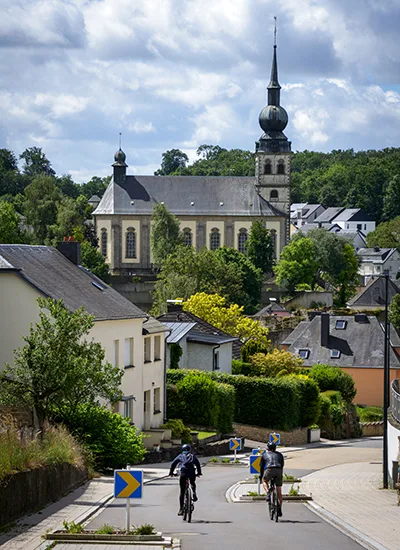
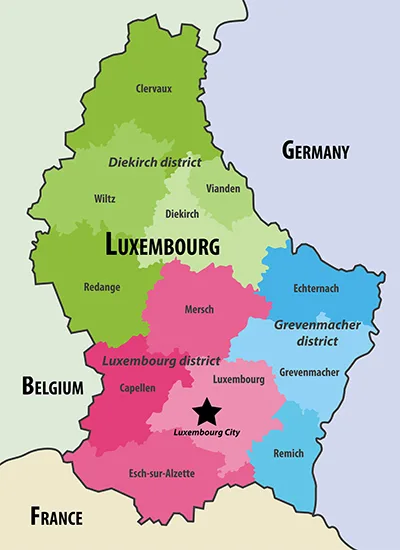
If travelling to Luxembourg by train from neighbouring Germany, France, or Belgium, there are also attractive rail links available from across the border.
Car rentals are another option for getting around Luxembourg with plenty of providers available, whilst there are also several bike rental points throughout the country. Whether you’re planning a leisurely ride through the picturesque countryside or an adventurous exploration of the vibrant city streets, cycling is the perfect way to discover the different facets of Luxembourg.
For exploring on foot, the capital is compact and very walkable, spanning just under 52 sqkm.


